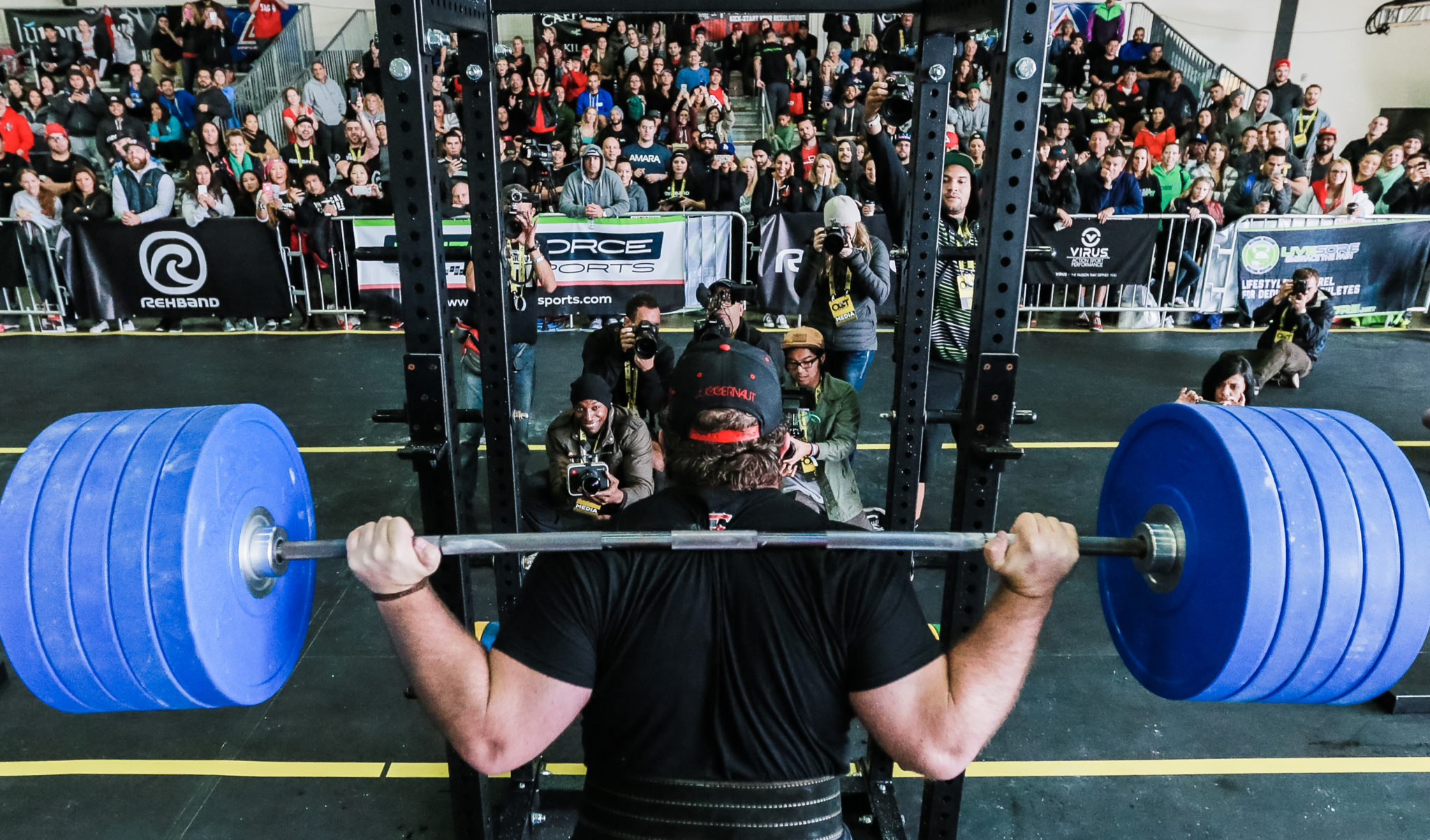Written by Chad Wesley Smith
In Part 1 of this series, we discussed what the concept of consolidation of stressors is and how it is applied to programming in the short term, a single training cycle. The foundation of consolidation of stressors hinges upon the idea of moving from higher volume/lower intensity/lower specificity training to lower volume/higher intensity/higher specificity training.
There are four main factors that are manipulated during the planning of training and the consolidation of stressors concept. They are:
Frequency: How often you are training and – more specifically – how often you are training your primary stressors.
Volume: Total workload of the training.
Intensity: What percentage of an exercise’s maximal output it is being performed at.
Specificity (Variation): How similar to the competitive exercise the exercises being performed are and how well they transfer to sporting performance.
During the short term, the manipulation of these four factors are very small in degree. As we move to the medium and longer terms, the changes become more drastic.
The medium term of training, for the purposes of this article, will be defined as the annual plan; depending on the athlete, this could also be a quadrennial. For powerlifting, an annual plan is a tougher idea to create, as meet schedules aren’t often known very far in advance or do not work toward a true National/World Championship (with the exception of the IPF). Since the annual plan for strength athletes is harder to define, we will look at consolidation of stressors in the training of football players but make sure to understand that these concepts can be similarly applied across many fields with a little aptitude and critical thinking.
A valuable tool in organizing training is to identify and classify training sessions into high, medium, and low intensity days. Doing this will better allow you to manage and manipulate your training frequency and build more recovery into your training as intensity increases.
The primary stressors I manipulate for the training of my football players are:
-Sprints (this includes all maximum speed movement drills)
-Jumps
-Throws
-Squat variations
-Bench variations
The secondary training includes:
-Aerobic capacity training
-Assistance lifting
Our offseason periods of training are divided into three main blocks of training in which the training schedule is consolidated to varying degrees. Those periods are work capacity, alactic power, and alactic capacity. Over the course of these three periods, training moves from more frequent and lower intensity training of the primary stressors and less specific training toward less frequent and higher intensity training of the primary stressors and more specific exercise selections. Let’s take a look block-by-block.
Work Capacity
This first block of the off-season training process is focused on building work capacity through frequent, high volume, moderate intensity relatively general training means.
Frequency during this period is high, with six weekly training sessions all featuring a few of the primary training means.
Because of the frequent nature of training at this point, total volume is inherently high.
With high frequency and high volume training, intensity must be kept down to avoid overtraining. There are several factors to consider with managing training intensity during this period of the year. First, the athletes are coming out of their season, so they are likely detrained to some degree in regards to strength, power, and speed; this will inherently reduce the intensity of their training. For example, if an athlete who previously ran a 4.6 40-yard dash, benched 315, and squatted 455 comes out of the season running a 4.75, benching 295, and squatting 405, then even his maximum output at the moment won’t be as stressful because it is less than they have achieved before. Managing intensity of weightroom movements is as simple as assigning percentages to the lifts. Most of the work in this period is done in the 55-75% range. Managing intensity for sprint training, jumps, and throws requires a bit more creativity though.
Explosive training like sprints, jumps, and throws need to be trained at at least 90% intensity to have the desired effect, but frequent training of maximal speed and power qualities is very stressful to the body and nervous systems. We can solve this problem by choosing exercises that allow the athlete to perform 90%+ intensity work but reduce the maximum output capabilities and save the athletes from over-stressing themselves. For example, during this period, we will utilize more sled resisted or hill sprints instead of flat land sprints, as these sprinting variations will reduce the athlete’s velocity and chance for soft tissue injury (specifically hamstring pulls) but still have positive carryover to the athletes sprinting speed and special strength for running. Jumps are also often done uphill during this period as they reduce the force of gravity during the landing. Throwing intensity is tough to manipulate, so it is only kept down during this period through higher volumes of throws and the fatigue that comes with it.
Specificity during this time period is relatively low, as general speed training (running in a straight line or preset pattern cone drills) is primarily used, and we have yet to introduce special strength exercises like various sled drills.
I would classify all of the training days during this period as medium stress because, while there are primary stressors present on every day, their intensity is being controlled and kept moderate. This block’s training schedule is as follows:
Monday-Sprints/Jumps/Bench Press/Upper Body Assistance Work
Tuesday-Throws/Aerobic Capacity Training/Squat/Lower Body Assistance Work
Wednesday-Sprints/Jumps/Bench Press/Upper Body Assistance Work
Thursday-Throws/Aerobic Capacity Training/Squat/Lower Body Assistance Work
Friday-Sprints/Jumps/Bench Press/Upper Body Assistance Work
Saturday-Throws/Aerobic Capacity Training/Squat/Lower Body Assistance Work
Sunday-Off
Using this type of schedule of pairing explosive lower body work and upper body weights together may seem counterintuitive, but it is done strategically to further control intensity. If you sprint on Monday, you can’t squat as hard on Tuesday; and if you squat on Tuesday, you can’t sprint as hard on Wednesday. This allows us to put more focus on technique and volume of work rather than only on intensity.
Alactic Power
The alactic power phase of off-season is where the greatest gains in speed and strength will be made. To achieve this, higher intensity training must be implemented. This, of course, is more stressful to the body and will require greater recovery, so we must consolidate our most intensive training to fewer days per week.
The training schedule during this period is as follows:
Monday-Sprints/Jumps/Squat/Lower Body Assistance Work
Tuesday-Throws/Aerobic Capacity Training/Bench/Upper Body Assistance Work
Wednesday-Sprints/Multidirectional Speed/Jumps
Thursday-Aerobic Capacity Training/Restorative Work
Friday- Sprints/Jumps/Squat/Lower Body Assistance Work
Saturday- Throws/Aerobic Capacity Training/Bench/Upper Body Assistance Work
Sunday-Off
This schedule allows you to train at higher intensities while still being able to adequately recover between sessions. In terms of high, medium, and low stress, classifications are as follows:
Monday-High
Tuesday-Medium
Wednesday-Medium
Thursday-Low
Friday-High
Saturday-Medium
Sunday-Off
Some may think that Tuesday, Wednesday, and Saturday’s training could be considered high intensity because of the throwing and bench press work, but unless you have an athlete who is an exceptionally strong bencher or talented thrower, they will have a very hard time having a high stress day with those exercises.
You can already see how frequency and volume are reduced using this schedule, but intensity and specificity are increased in multiple ways.
At this point in the off-season, your athletes are getting stronger and faster. They are capable of higher outputs that will be more stressful to their muscular and nervous systems. For them to continue to progress, they now need greater overload, so speed work has moved from primarily drills and hill/sled sprints to flat land work and some “flying work”(submaximal lead in to maximal speed section to allow for greater velocities to be achieved). Jumps are adding intensity through increased contacts per effort (2-4 successive bounds vs 1-2 in work capacity block) and moving to flat land from hills for increased distance. In the weightroom, percentages are increased and the athletes are getting stronger, so all weights are just higher/more stressful.
Specificity of training is gradually increasing at this point; the introduction of flat land speed work over hill/sled work is certainly more similar to running in a game. Also, we will use various sled drills for linemen like heavy sled pushes and sled pushes into sprints. All speed training during this phase is focused on developing alactic power and must be done with complete rests. The multi-directional speed training on Wednesdays also lends itself to increased specificity as football is rarely a game played in straight lines.
Alactic Capacity
The third and final block of the off-season is dedicated to alactic capacity or the ability to reproduce high-level efforts with incomplete rest periods (aka, conditioning for football is the most intense and stressful part of the off-season’s training).
The schedule is as follows:
Monday-Sprint/Jump/Throw/Bench/Squat
Tuesday-Aerobic Capacity Training/Restorative Work
Wednesday-Sprint/Jump/Throw/Accessory Weights
Thursday-Aerobic Capacity Training/Restorative Work
Friday-Sprint/Jump/Throw/Squat/Bench
Saturday/Sunday-Off
There are two very high stress (Mon/Fri) days, one medium/high stress day (Wed) and two low days (Tues/Thurs), as well as two off days. It is necessary to build in this type of recovery to your training once you have consolidated your primary stressors to few super high intensity sessions.
Total volume is relatively low during this time due to the low frequency, though the speed training volumes of the Mon/Wed/Fri sessions are rather high, as running is what they must be most prepared for as they enter practice periods soon. (They are doing things more similar to their competitive exercise as they get closer to the competition period.)
Specificity is also further increased as more attention is given to special exercises like sled pushes, sled explosions, and sled push and sprint. Also for speed training, we often use competitive simulations like 1 on 1s and various tag drills based on position.
Intensity in the weightroom is high, but volume is very low because of the stress/stimulus the field work presents. We will also use some exercises like bounce press or reverse band press to allow for an overload and more specific pressing action.
Consolidation of stressors in the medium term is a manipulation of frequency, volume, intensity, and variation over time. Structuring your training with these principals in mind will allow you to build in more recovery to the structure of your plan. While strength and speed qualities increase, recovery comes at more of a premium, and you need to facilitate more time for your athletes to recover. Creating an annual plan with these principals in mind will help guide your athlete’s development over the course of a long off-season.
Related Articles
[Strong360] Fine Tune your Frequency
Consolidation of Stressors: Part 1
Chad Wesley Smith is the founder and head physical preparation coach at Juggernaut Training Systems. Chad has a diverse athletic background, winning two national championships in the shot put, setting the American Records in powerlifting, including a 900+ raw w/ wraps squat and a 2200+ total, and winning the 2012 North American Strongman championship, where he earned his pro card. In addition to his athletic exploits, Chad has helped over 50 athletes earn Division 1 athletic scholarships since 2009 and worked with many NFL Players and Olympians. Chad is the author of The Juggernaut Method and The Juggernaut Method 2.0 and The Juggernaut Football Manual. Facebook, YouTube, Twitter







